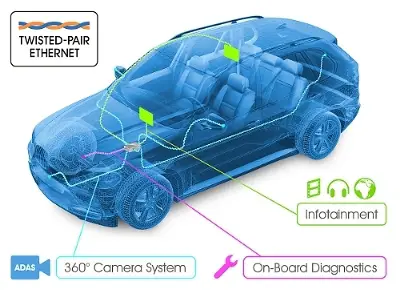Automotive Ethernet Hits the Road in Wide Range of New Vehicles
 |
BMW, Jaguar and VW among Growing Number of Car Makers to Rely on Standardized Ethernet to Deploy Advanced Infotainment and Driver Assistance Features
DETROIT -- Oct. 14, 2015: The OPEN Alliance (One-Pair EtherNet) Special Interest Group (SIG), a non-profit industry alliance established to drive wide scale adoption of Ethernet-based automotive connectivity, today announced a significant increase in the number of car models to adopt OPEN's automotive Ethernet standard, based on BroadR-Reach� technology. Leveraging the performance and cost advantages of the automotive-qualified technology, automakers can easily deploy advanced infotainment and driver assistance features, such as surround-view parking, lane-departure warning and collision avoidance systems, across a broader range of vehicles. Visit OPEN for more information.
A growing number of the world's leading car makers have adopted one-pair automotive Ethernet technology as their connectivity solution of choice in a vast range of vehicles, including the BMW X3, X4, X5, X6, i3, i8, 6 Series and 7 Series vehicles; the Jaguar XJ and XF; and the Volkswagen Passat.
"There is no doubt that consumer demand for advanced driver assistance and infotainment features are on the rise," said Dr. Kirsten Matheus, Ethernet Project Manager at BMW. "One pair automotive Ethernet technology provides a single, centralized network backbone that simplifies the deployment of advanced features."
"In the past, automakers relied on a variety of connectivity solutions in each of the isolated domains inside the vehicle," said Dr. Ali Abaye, Senior Director of Automotive at Broadcom. "BroadR-Reach automotive Ethernet technology enables automakers to introduce luxury-model safety and infotainment features throughout the fleet, including mid-range and economy class vehicles."
"Since the formation of the OPEN Alliance, interest in one pair automotive Ethernet technology has risen at a dramatic pace. Today, membership in the SIG stands at nearly 300 auto and tech companies, representing a 36X increase in just four years," said Natalie A. Wienckowski, Strategy Lead, Core Hardware Team at General Motors and Chair for the OPEN Alliance SIG. "As the automotive industry accelerates adoption of Ethernet based networks, the implementation support provided by OPEN is invaluable to its members."
"Standards-based solutions such as BroadR-Reach automotive Ethernet not only reduce time-to-market, they also ensure availability, lifecycle, upgradability and interoperability," said Ian Riches, Director, Global Automotive Practice, Strategy Analytics. "Now that a secure system backbone is in place, connected car development is kicking into high gear. We're predicting up to one-half billion Ethernet ports to be deployed in cars by 2020."
Availability In addition to Broadcom Corporation, several major semiconductor suppliers have licensed or incorporated the technology into their portfolio of automotive chips and modules, including Freescale and NXP. Broadcom, NXP and Realtek will present a joint demonstration at the IEEE Ethernet & IP @ Automotive Tech Day, October 27 – 28, 2015 in Yokohama, Japan.
About the Technology The Open Alliance automotive Ethernet standard delivers high-performance bandwidth of 100 megabits per second (Mbps) per port while dramatically reducing connectivity costs and cabling weight. The fully automotive-qualified technology integrates specialized, separate systems into a centralized, secure platform, allowing multiple end points to simultaneously access and communicate information with a single protocol for data transfer.
The OPEN Alliance has worked closely with IEEE in order to drive further innovation and standardization. The specification of a BroadR-Reach compliant IEEE standard is about to be finalized as IEEE 100BASE-T1. The release of a next generation IEEE 1000BASE-T1 technology is expected in early 2016.


